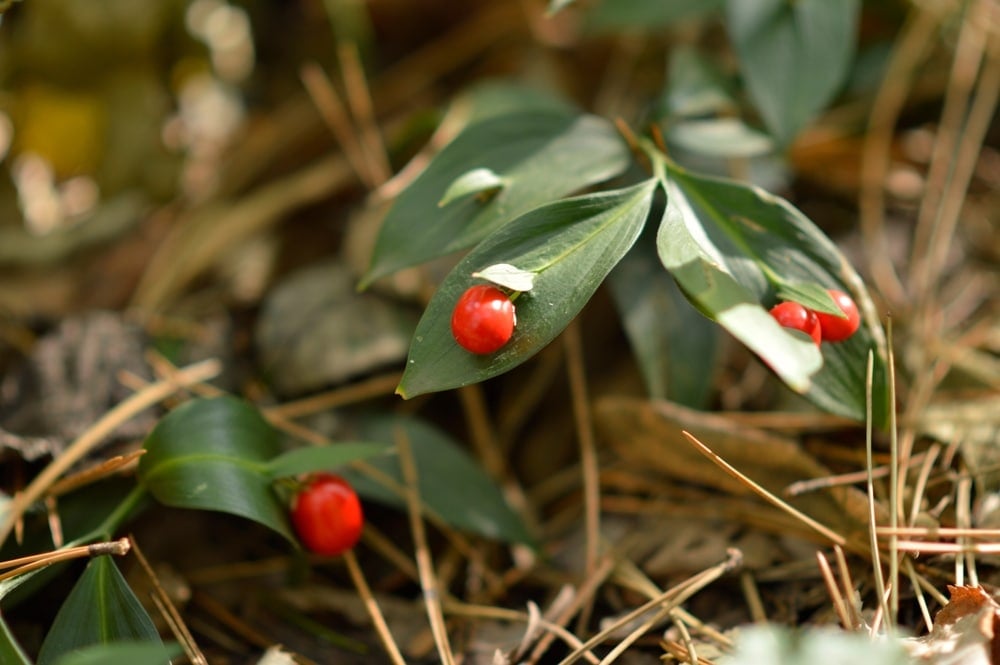
Butcher’s Broom Plant Profile
Introduction
Ruscus aculeatus, commonly called butcher’s broom, is a hardy evergreen subshrub prized for its distinctive “leaf-like” cladodes, winter berries, and deep-shade tolerance. Beyond its traditional use in European herbalism, it’s an elegant understory plant for woodland gardens and shaded borders.
Taxonomy & Common Names
-
Family: Asparagaceae
-
Genus/species: Ruscus aculeatus
-
Common names: Butcher’s broom, knee holly, sweet broom
Botanical Identification
-
Habit: Compact, rhizomatous evergreen subshrub forming dense clumps.
-
Cladodes (leaf-like shoots): Flattened, oval to lanceolate, with a sharp tip; true leaves are tiny and scale-like.
-
Flowers: Small, greenish, often solitary, borne in the center of the cladode in spring.
-
Fruit: Bright red berries (on female plants), persisting into winter; seeds are bird-dispersed.
-
Roots: Thick rhizomes that allow slow spreading and clump formation.
-
Size: Typically low-growing, making it ideal for ground-level planting in shade.
Habitat & Distribution
Native to parts of Eurasia and North Africa, butcher’s broom thrives in woodlands, hedgerows, and coastal cliffs. It tolerates deep shade, wind exposure, and nutrient-poor or heavy soils, provided drainage is reasonable.
Phenology & Reproduction
-
Flowering: Spring.
-
Fruiting: Late season, with red berries often persisting through winter.
-
Seed biology: Seeds benefit from a cold stratification period and can take many months to germinate.
-
Vegetative spread: Rhizomes allow slow, reliable clump expansion.
Cultivation & Growing Conditions
-
Light: Prefers partial to deep shade; foliage can scorch in strong, direct sun.
-
Soil: Adaptable—from well-drained loam to heavier clays; avoid waterlogged sites.
-
Water: Once established, relatively drought-tolerant; moderate, even moisture is ideal.
-
Exposure: Handles wind and coastal conditions; evergreen interest through winter.
-
Containers: Grows well in pots for shaded patios or north-facing entries.
-
Care: Generally low-maintenance; prune out any damaged cladodes after winter.
Propagation
-
Division: Split rhizome clumps in autumn or early spring; replant divisions at the same depth.
-
Seed: Sow fresh seed; provide a cold period. Germination is slow and variable—many months to a year or more.
-
Tip: For predictable results in gardens, division is the most dependable method.
Harvest & Handling
-
Shoots: Young spring shoots have traditional culinary uses.
-
Rhizome: Typically lifted in autumn for drying and further preparation.
-
Sustainability: Harvest modestly from established clumps; avoid over-digging to preserve plant health.
-
Handling: Cladode tips are sharp—use gloves when dividing or pruning.
Look-Alikes & Identification Notes
-
The hallmark is flowers and (on females) berries arising from the center of the cladode—a distinctive trait that helps separate it from unrelated evergreen shrubs.
-
When in doubt, check for the tiny central flower scar or fruit attachment on the cladode surface.
Conservation & Garden Ethics
-
Naturalized in many regions; check local guidance before planting near sensitive habitats.
-
In gardens, it spreads slowly—rarely a nuisance—but always dispose of garden waste responsibly.
For a complete academic overview, see our Butcher’s Broom (Ruscus aculeatus).
Frequently Asked Questions
What does butcher’s broom look like?
A low, evergreen subshrub with flat, leaf-like cladodes ending in a sharp tip. Small greenish flowers and, on female plants, bright red berries appear from the center of the cladode.
Where does it grow best?
In partial to deep shade with reasonably drained soil. It adapts to clay, lean soils, and coastal exposure once established.
How do I propagate butcher’s broom?
Division of rhizome clumps in autumn or early spring is most reliable. Seeds need a cold period and can take many months to germinate.
When should I harvest?
Young shoots are taken in spring; rhizomes are typically harvested in autumn. Harvest conservatively to keep clumps vigorous.
Is it invasive or protected anywhere?
It’s naturalized in some places and valued in others. Always check local guidance before planting or foraging, and avoid introducing it near sensitive habitats.
Is it suitable for containers?
Yes—its compact habit and shade tolerance make it a solid choice for containers in low-light areas.
Masterful Display
Each and everyone of our products are deeply considered, labored over, and improved upon time and time again. We invite you to experience the difference of our carefully crafted small batches of herbal support items. Whether it be our tea line, produced for a delightful experience, or our tincture blends and extracts, we have what you need.

